| enter keyword to search: |
|
Images db
|
|
|
Articles db
|
|
|
|
|
|
|
| Koricancha
the temple of the sun |
|
Dedicated to the cult of the sun god, Koricancha the Golden Precinct (also spelled Coricancha or Qoricancha, qorikancha) was the most important temple of the Tahuantinsuyu. This was a religious complex constituted by temples dedicated to different deities. It had a layout very similar to that of a classical "kancha"; with enclosures around a central patio and a terraced garden reaching the Saphi river banks, today the river is covered by the Avenida el Sol. The quality of the building was extraordinary, the walls are made with gray basaltic andesites in the 'Sedimentary' or 'Imperial Inkan' type that is the maximum expression of architecture in pre-Columbian America.
The main gate, almost in the same position of the present day entrance of Santo Domingo Convent, overlooked the Intipanpa (Sun Plaza).
Koricancha |
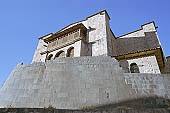
|
The Sun Temple occupied the space of Santo Domingo Church. It was completely demolished except the wall known as solar round building. The temple had a rectangular plan, its four walls and even the wooden ceiling were completely covered with gold (the tears of the sun). The Main Altar, now completely lost, would have contained representations of the Sun God with Wiraqocha and Thunder God (Chuquiylla Chuki Illapa). On both sides of the altar were the "Mallki" (mummies or embalmed bodies in a foetal position) of the dead Inkas.
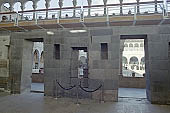
|
Koricancha
|
The Moon Temple or Mamakilla (the Sun's wife) was located adjacent to the Sun Temple. It was almost completely destroyed in order to built the Church. Remains are limited to its eastern wall with the classical trapezoidal niches and one of its gates. Between those niches is the horizontal dark stripe that is believed to be the support zone of the silver plates (the tears of the moon) that covered completely its walls. In the center of the temple there was a silver representation of the Moon and on both sides of it the embalmed bodies of the dead coyas ( or Qoyas = Queens) the wives of the Incas.
Beside the temple of the Moon there is the Temple of Venus (Ch'aska) and the Stars. Three walls of the temple are original, the fourth wall is a reconstruction. The Venus Temple has a considerable size; it is surrounded by 25 trapezoidal niches. Also here there is a horizontal stripe that supported the silver "planks" covering this temple. It has two very high entrance gates and in the wall, between them, are two trapezoidal niches with very special carvings called "tabernacles".
In front of the Stars Temple, on the other side of the present day central patio is the Temple of Thunder (Illapa or Chuki Illapa). This deity is a combination of thunder, lightning and thunderbolt, considered the ‘servants of the sun’; its shrine was adorned with gold. This temple is smaller than the other ones, it has 3 trapezoidal single jamb doorways with the classical trapezoidal niches and two windows in its lateral walls, one lateral wall is partially reconstructed.
Beside the Illapa sanctuary is the Temple of Rainbow (K'uychi), partially mutilated by the construction of the Dominican Convent. The Rainbow was another important divinity in the Inkan Society, the Inka adopted it as their emblem. The same banner with the 7 colours of the rainbow has been recovered today as Qosqo City's flag.
Inside the complex there were other enclosures for the priests and for sheltering the different idols, like the famous Punchao, a representation of the Sun that consisted of a pure-gold statue that was as high as a ten-year old kid. during the night accompanied by many ñustas This statue was taken to sleep in a close shed. In the morning the idol was then returned to the outside.
Koricancha |
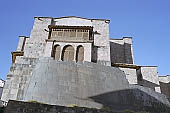
|
In the southern sector there was the Qorikancha's Solar Garden a terraced field that reached the Saphi River banks. This was a very special garden containing local flora and fauna and even persons sculpted in natural size, made of gold and silver. The garden was filled with life-size golden sculptures representing gods, deities and the entire creatural world: golden corns, trees, animals, fruit, butterflies, birds, tools for the land cultivation, llamas, corn, babies, plants, flowers, rocks and butterflies. There were also five Water Fountains, with religious purposes as water was a deity in the Andean Religion; they were also adorned with precious metals, golden spillways, and large gold and silver jars.
With recent archaeological works one of the 5 fountains has been uncovered. It is located down in the garden in front of the ‘solar round wall’; water still flows through its finely carved channels.
To day in the middle of the cloister there is a fountain carved in a single andesite piece probably made colonial times with local manufacture.
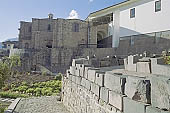
|
Koricancha
|
The site was arranged following the magical-religious projection of Tawantinsuyo sacred geography. It was laid out as to be the convergence of ceques, the lines connected to the various 'huacas' or power spots positioned in the nearby area. Emanating from the temple there were forty-one ceques, all connected to significant celestial points on the horizon like the equinox and solstice points, the heliacal rise positions of the Pleiades and other stars and constellations highly important to the Inca. Between 328 and 365 huacas or shrines were situated along a system of 41 ceques, 21 of which were located on the external wall of the temple or on the nearby streets. The huacas consisted of natural features such as springs, unusual rocks, and caves as well as artificial structures such as elaborately carved rocks, fountains and pools, and temples. The 328 huacas represented successive days of the sidereal lunar calendar, and that the flow of time in the Inca world was marked by worship services at consecutive huacas by different kin groups. Every huaca had prescribed sacrifices to be made on specific days. Most of the sacrifices were not human, but 32 of the shrines required human sacrifice, usually of children. Being the central point of the administrative divisions of the Tahuantisuyo empire, the four "suyos" began and converged in the Koricancha, and four of the ceques represented the four cardinal roads to the four quarters of Tawantinsuyu,
The Inca also used the Koricancha in conjunction with standing stones called sucancas positioned on the horizon of nearby mountains for determining the dates of the solstices and equinoxes. The great temple also incorporates a prominent solar alignment using a nearby peak called Pachatusan as a sightline for the June solstice.
Koricancha |
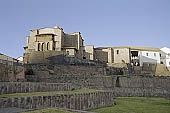
|
In all its splendour Koricancha was seen only by Pizarro's soldiers. When the Spaniards conquered Cusco all the gold ornaments that filled the site where stolen and the temple was donated to the Dominican Order that immediately constructed their church and convent demolishing it almost completely. Anyhow a considerable amount of the original Inca structure was left and integrated into the church structure.
As can be seen today, Koricancha is a classic example of the fusion of Inca and Western cultures, and the single tower of the convent built in the Baroque style, rises above the tile roofs of the city.
In 1950 a violent earthquake destroyed a large part of the convent and church leaving uncovered many Inkan structures and the interior area of the "Solar Round Building". By that time a strong "Indigenous Movement" suggested the relocation of the church and the recovery of the Sun Temple.
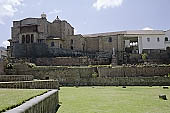
|
Koricancha
|
|
Related Pages
-
-
-
-
-
-
-
-
|
|
|
 |
|
|



